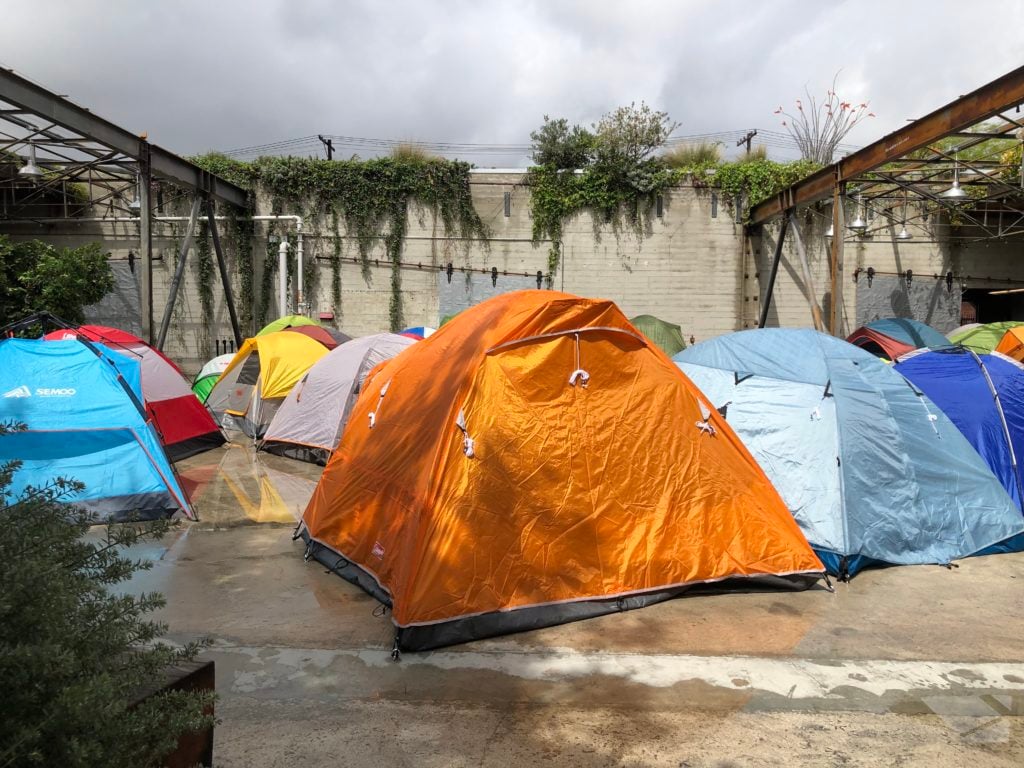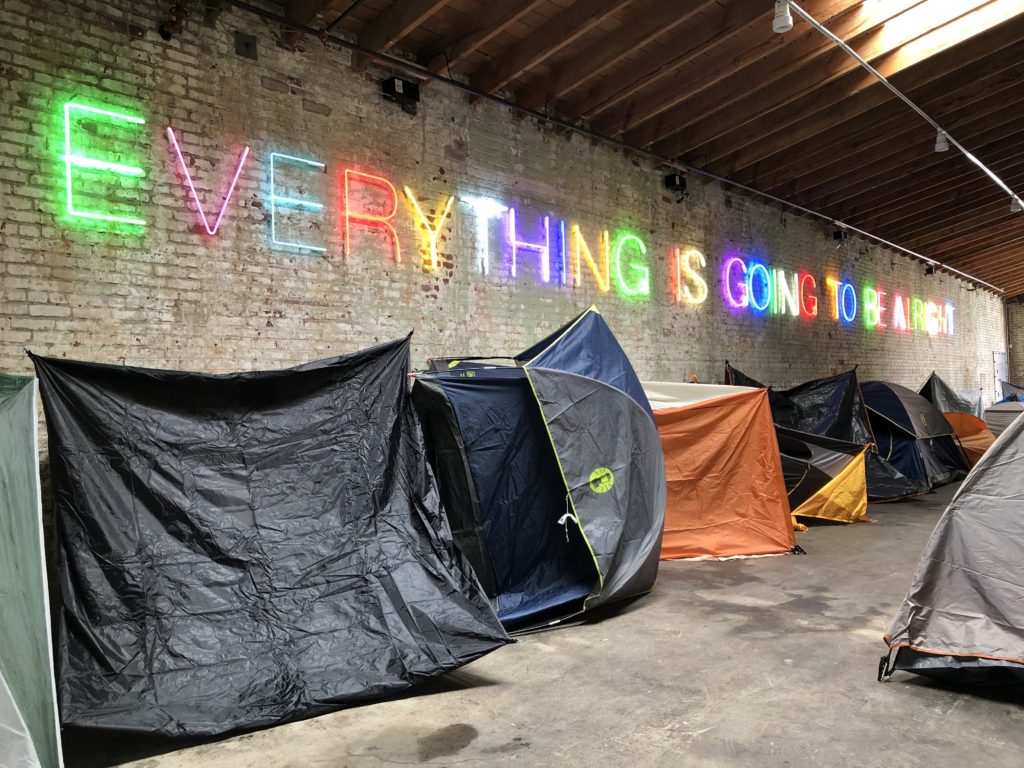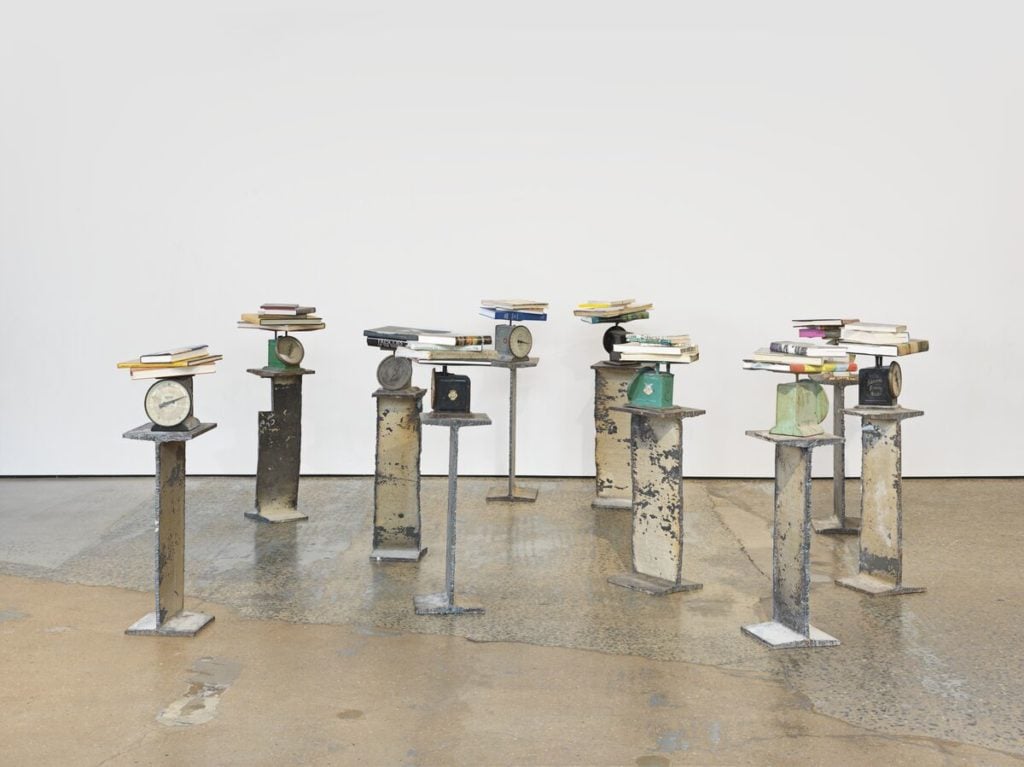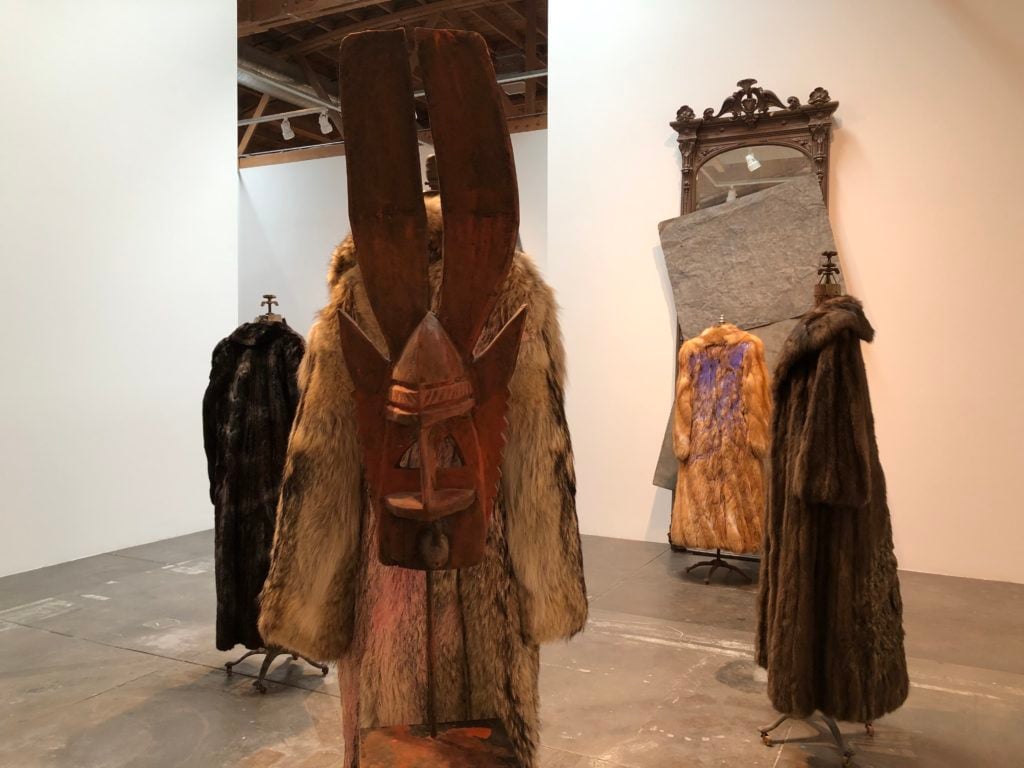On View
A Few Blocks From Skid Row, David Hammons’s New Show at Hauser & Wirth Asks Angelenos to Imagine Themselves as Homeless
The artist has installed tents in the gallery's courtyard that are stenciled with the phrase “This could be u."

The artist has installed tents in the gallery's courtyard that are stenciled with the phrase “This could be u."

Janelle Zara

In downtown Los Angeles, the four blocks that separate Skid Row from Hauser & Wirth is normally enough distance for gallery goers to put the swelling encampment of the homeless out of sight and out of mind.
But the artist David Hammons is currently collapsing that space by filling the gallery’s outdoor courtyard with tents, ominously stenciled in red with the words “This could be u. This could be u and u.” As the tents proceed down a corridor, they rob an existing Martin Creed installation of its credibility: EVERYTHING IS GOING TO BE ALRIGHT, the British artist’s rainbow of neon letters reads above a row of Hammons’s tents.
The centerpiece of Hammons’s triumphant return to Los Angeles—his first time showing in the city in 45 years—combines two defining features of the city’s urban fabric: expansive blue, nearly cloudless, skies and a general apathy among the moneyed elite for the poor.
Hammons lived in LA from 1963 to 1973, during which time he studied under Charles White at the Otis College of Art and Design, and had his first solo exhibition in 1971 at Brockman Gallery in Leimert Park. After moving to New York, his open disdain for the art world has made him one of its more elusive, and consequently mythologized, figures.

Installation view of “David Hammons” at Hauser & Wirth, Los Angeles. Photo: Janelle Zara.
Greeting gallery visitors with Hammons’s acerbic brand of institutional critique, both of the racist subtext underlying American life and the absurdities of the art world, the tents are the most pointed allusion among others that are more shrouded in physical and conceptual layers of opacity. As usual, Hammons refuses to do the work for you, providing no explanations for his work by way of convenient checklists or artist statements.
Collectors intermingled with journalists on the preview day to mine the extraordinary breadth of works—paintings, film, and assemblage—for their conceptual origins. There’s a pair of red, medieval-style doors that recalls a moment in a 2002 New Yorker profile of Hammons in which he throws rice onto the steps of a church. Writer Peter Schjeldahl describes it as a “forlorn bit of evidence of a wedding that never took place.”
The exhibition sprawls. Paintings—shrouded in fraying tarpaulins, patch-worked fabrics, and clear plastic sheets—are mounted in various states of undress. One is wrapped in sheets of brown paper that have been burrowed through, exposing the brushstrokes of purples and reds inside. There’s a scrap of soiled white cloth wedged in the crack of an old window pane. Books on art history are stacked on vintage scales propped on vertical metal beams. Hammons’s Kool-Aid paintings, pigmented from the artificially colored drink, are framed in terrycloth, with torn packets lying below.
Hammons has an affinity for visual puns: a chaise longue covered in hair collected from a black barbershop (hair relaxer), rocks on wheels (rolling stones). There’s a series of photographs hung salon style that were taken in the city of Obama, Japan, labeled in pencil on the wall as “Obama Shrine,” “Obama Castle,” “The First Chief of Obama Feudal Clan 1634.”

David Hammons, Untitled (2018). © David Hammons, photo: Genevieve Hanson, courtesy of Hauser & Wirth.
A commercial freezer, the kind a bodega would fill with ice cream, is plugged into a conspicuous extension cord hanging inelegantly from the ceiling and is stocked with copies of a book by art historian Elena Filipovic, titled David Hammons: Bliz-aard Ball Sale. The book’s subject is Hammons’s great 1983 work, Bliz-aard Ball Sale, in which the artist sold snowballs on a woven blanket on the corner of a Lower Manhattan sidewalk priced according to size, conflating the hustle of the art market with that of the bootleg street vendor, and highlighting the absurdist notion of either art or snowballs having a monetary value.
Hammons has famously refused any strict gallery representation and the walls of this show are covered in penciled phrases characterizing irritating dealer-artist negotiations that often happen prior to a gallery show: IT’S BEEN DONE BEFORE. THESE REMIND ME OF. HOW MANY OF THESE DID YOU MAKE. But Hammons’s actions that spite the mores of the art world, or more accurately, the art market, have done little to diminish his ascent into the top 10 most expensive living artists in America.
There’s one snowball that lives on in the exhibition as a bowl of water, propped onto an ornately carved wooden shelf like the holy water font that flanks the doors of a church. Next to it is a framed printout presumably from a collector, “As much as we would love to own a snowball, not a single insurance company would cover it for us […] Since we are not made of money like SOME people […] we will have to pass. But then again, if you come across any other interesting Hammons…”

Installation view of “David Hammons” at Hauser & Wirth, Los Angeles. Photo: Janelle Zara.
Prior to the opening, Hammons issued a very limited press release, dedicating the exhibition to the late jazz musician Ornette Coleman. An accompanying drawing, a composition of meandering horizontal lines that occasionally take wayward detours down the page, evokes the controlled chaos of Coleman’s improvisational saxophone playing. Veering away from western notions of tonality, Coleman’s theory of harmolodics created a non-hierarchical relationship between harmony, melody, rhythm, and speed that was influenced by his travels to West Africa. Hammons’s press release describes Coleman as a “Harmolodic Thinker,” one not beholden to prescribed standards, musically or otherwise. And that’s all it says.